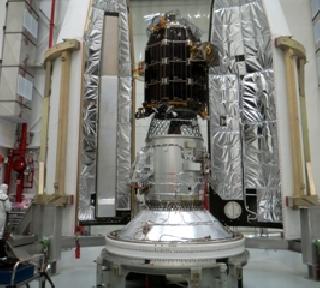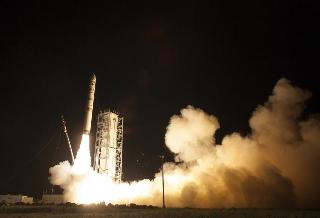
Lunar Atmosphere and Dust Environment (LADEE) spacecraft. Photo: NASA Ames
HOUSTON (PTI): NASA's newest robotic explorer, launched from Virginia to unlock the mysteries of Moon's atmosphere, has run into rough waters by developing a glitch hours after liftoff.
NASA engineers have fixed the glitch that threatened to derail the space probe on its way to the moon, the space agency said on Monday.
The Lunar Atmosphere and Dust Environment Explorer (LADEE) suffered a "reaction wheel issue" soon after it was launched on top of a 90-foot rocket from the Mid-Atlantic Regional Spaceport, at NASA's Wallops Flight Facility, Virginia, on Friday, NASA officials said.
They reported that the spacecraft's reaction wheels which spin to position and stabilise LADEE in space without using precious thruster fuel unexpectedly shut down.
By Saturday afternoon, the glitch had been traced to safety limits programmed into LADEE before launch to protect the reaction wheel system, NASA officials said.
Those fault protection limits caused LADEE to switch off its reaction wheels shortly after powering them up, according to a mission status update.
Engineers have since disabled the safety limits causing the glitch and taking extra care in restoring the fault-protection protocols.
"Our engineers will determine the appropriate means of managing the reaction wheel fault protection programme.
Answers will be developed over time and will not hold up checkout activities," NASA's LADEE project manager Butler Hine said in a statement.
"The reaction wheel issue noted soon after launched was resolved a few hours later," added NASA Ames Research Centre director Pete Worden.
"The LADEE spacecraft is healthy and communicating with mission operators."
NASA's Ames centre developed and built the LADEE spacecraft, and is overseeing its mission operations.
NASA's USD 280 million LADEE moon mission is aimed at studying the moon's thin atmosphere and solving long-standing mysteries of the moon's dust. The atmosphere of the moon, known as an "exosphere," is so thin that individual molecules don't interact with each other.
Similar environments have been seen on Mercury, the moons of outer planets in the solar system, as well as some asteroids, so scientists are hoping LADEE will help better understand these strange environments.
LADEE scientists also hope the mission will yield insights into the odd "lunar glow" spotted on the moon's horizon by Apollo astronauts during NASA's lunar landings in the 1960s and 1970s.
The mission will also track how moon dust moves across the lunar surface, which is key interest because the abrasive stuff can stick to spacesuits and clog up systems on future moon vehicles and rovers.
LADEE will take about 30 days to reach the moon and spend 100 days performing its lunar atmosphere and dust mission.
The spacecraft will also test a new laser communications system that NASA has billed as a kind of new "interplanetary Internet".
At the end of its mission, LADEE will plummet down to the moon and crash into the lunar surface.
 Previous Article
Previous Article Next Article
Next Article













The Indian Air Force, in its flight trials evaluation report submitted before the Defence Ministry l..
view articleAn insight into the Medium Multi-Role Combat Aircraft competition...
view articleSky enthusiasts can now spot the International Space Station (ISS) commanded by Indian-American astr..
view article